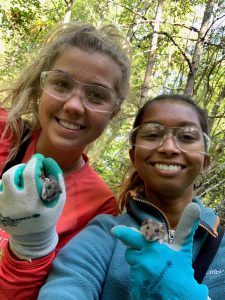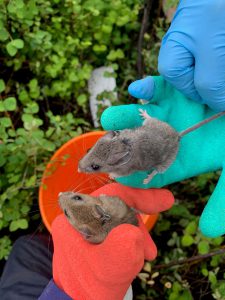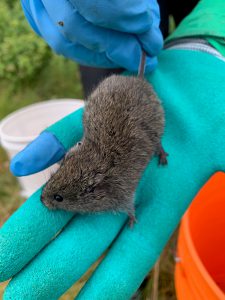Okanagan Small Mammal Inventory Project
Categories:

By Sabina Pereira
Last summer I was employed with BC Parks and Thompson Rivers University working on the Okanagan Small Mammal Inventory Project. The goal of the project was to identify which species of small mammals were present in various protected areas in the North Okanagan and create a list for research and management purposes.
Small mammals are an undervalued part of ecosystems. Most people I spoke to this summer were quick to share their stories of mice invading their RV’s and sheds or chipmunks hijacking their bird feeders. They were very interested in seeing deer mice and voles up close but shrieked in fear at any movement from the tiny creatures. They were surprised to learn that small mammals play a critical role in nature’s food web.

Small mammals including mice, voles and shrews, eat plant material and insects, and they in turn are eaten by snakes, birds of prey and larger mammals. Knowing about the small mammals in the wild helps conservationists determine what predators are feeding on.
We sampled four provincial parks in the North Okanagan: Kekuli Bay, Kalamalka Lake, Ellison and Enderby Cliffs. We also sampled Campbell Brown Ecological Reserve. Each protected area offers unique landscapes, habitats and animals. About 120 live-traps were set out in every protected area at night and baited with whole oats, sunflower seeds and apple chunks. Trapped animals were identified to species, and the sex, age, reproductive stage and weight were recorded, along with recording any ticks or botflies they had on them. Finally, we gave them an ear tag and released them.
Most often, we found deer mice (Peromyscus maniculatus) in the traps – both gray and brown varieties. Their big round ears, white belly, large black eyes and long, bicolored tail help identify this species. Most people encounter deer mice that have gone into places like campers to find food or sheds to nest in grass clippings. Although they are virtually harmless, be careful when handling deer mice as they are carriers of the respiratory disease Hantavirus.
If you do encounter deer mice, remember they are more scared of you than you are of them. Give them space to escape and they will scurry off. To avoid encounters, pack food in airtight containers and keep food scraps and garbage packed away until it can be disposed of properly. Mice are crafty and determined when it comes to finding food.

Another common animal that we found were voles. There are a few species native to the Okanagan, but we mostly encountered the meadow vole (Microtus pennsylvanicus). Meadow voles are stout and chunky with thick dark brown fur, nearly invisible ears, and short, skinny tails. Their legs are short, and their face is cone-shaped, which helps them scurry under dead grass and other vegetation. They are very fearful and will bite if handled or threatened.
Similar to the meadow vole is the long-tailed vole (Microtus longicaudus). We only encountered this species in one protected area, but it was really exciting to see because it is considered rare in the Northern Okanagan. The long-tailed vole is almost identical to the meadow vole but, as its name suggests, it has a much longer tail.
After spending time trapping and educating others about small mammals, I have a greater appreciation for their role in our ecosystems. The most rewarding experience of the summer was watching volunteers gain confidence working with small mammals over the course of just one morning. They would often begin their day feeling a bit wary, but once they handled their third or fourth animal they had smiles on their faces and were posing for pictures. I know that anyone who takes the time to learn about small mammals will gain a better understanding for their importance in nature and grow a little less scared of nature’s tiny helpers.
The Okanagan Small Mammal Inventory Project is supported through the BC Parks Licence Plate Program. So far, more than 180,000 specialty licence plates have been sold, supporting over 220 programs and projects related to conservation, community engagement and education and Indigenous relations.




